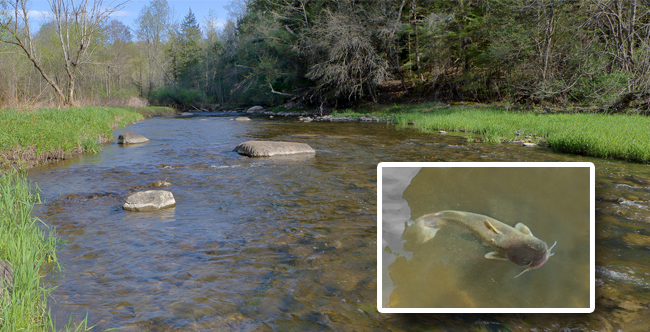It’s a warm bluebird day along the La Platte River, and a group of students and volunteers are planting and watering trees, when suddenly a call rings out from the riverbank, “Look! It’s a weird little fish!” Young people and adults alike bound across the planting site to gaze upon a small tadpole-shaped creature swimming in lazy circles around a grapefruit-sized rock. A hush descends over the group as Land Trust staff identify the creature as an elusive Stonecat, a type of small catfish that is rare in Vermont.
Our Upper La Platte River Natural Area is home to a documented population of Stonecat. This nocturnal fish rarely appears during the day, and grows to between 5 and 7 inches in length. It spends its entire life under or between stones, hence its simple, but descriptive name. The Lake Champlain Land Trust has been involved in intensive restoration efforts at the Upper La Platte River Natural Area since permanently conserving the now 85-acre community treasure in 2011.
In order to keep sediment from flowing off the land and muddying the river’s waters, the Lake Champlain Land Trust and its enthusiastic volunteers have planted over 1,300 sediment-capturing trees along the La Platte River. In addition to protecting water quality, these trees help safeguard the La Platte’s Stonecat population.
View a photo gallery of our hardworking volunteers.
Stonecats only live in streams that feature a mix of cobbles and larger rocks, low sediment input, and a moderate current. In Vermont, the Stonecat has been found only in the La Platte and Missisquoi rivers, making the Lake Champlain Land Trust’s riverbank-tree-planting efforts at the Upper La Platte River Natural Area even more important to the survival of this unique fish.
According to Betsy Puchala, a researcher with the Vermont Cooperative Fish and Wildlife Research Unit who studies the Stonecat, if too much sediment fills the spaces between rocks and the stream bottom, it leaves the fish with nowhere to hide, making them vulnerable to predators. Excess sediment can also negatively impact the Stonecat’s preferred food—aquatic insects that live on the river bottom.
The Stonecat belongs to a group of diminutive freshwater catfish with unique spines on their backs. Puchala notes that, “for little fish without scales these spines can be a good defense mechanism.” According to Puchala, who has been accidently poked a few times during her field work, getting plucked by a Stonecat spine “feels a bit like a bee sting.”
The tree planting restoration project, in partnership with the UVM Sea Grant Program, is made possible thanks to funding from the Vermont Department of Environmental Conservation’s Ecosystem Restoration Program and other generous supporters. In total, the Lake Champlain Land Trust is restoring more than a mile of frontage along the La Platte River through a series of community tree plantings.
“The Lake Champlain Land Trust is committed to protecting rare species that inhabit Lake Champlain and its tributaries. We thank our many dedicated community volunteers, including students from Vergennes Union High School, Middlebury Union High School, and Shelburne Community School, for helping us restore floodplain forests along the La Platte River to protect this critical safe haven for Stonecat,” commented Chris Boget, Executive Director of the Lake Champlain Land Trust.
Back at the tree planting site, the students capture images of the Stonecat with their cellphone cameras to show friends and family. The dinner-table and school-hallway conversations sparked by these photographs are sure to instill pride in the students for their contribution to protecting these unique fish—and hopefully inspire a lifetime passion for conservation.
Thanks to the hard work of the tree planting volunteers and the Lake Champlain Land Trust’s long-term restoration efforts, the Stonecats of the La Platte River now benefit from the water quality and habitat improvements of a restored river system.
Would you like to help out? For more information about volunteering with the Lake Champlain Land Trust, visit our volunteer webpage.
If you would like to take action right now, you can help us plant more trees to protect both the Stonecat and the water quality of Lake Champlain.


